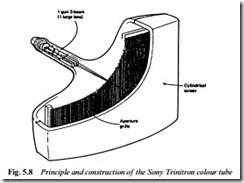TUBE SETTING UP
A typical set-up procedure for an in-line tube with green gun central, and adjustable neck rings and yoke is as follows: Allow 20 minutes for tube warm-up, then switch off red and blue guns and pull back the deflection yoke towards the guns. Adjust the two-pole purity ring magnets for a central green stripe on the screen, then push the yoke forward for a full pure green screen. Clamp the yoke securing band at the middle of the range over which there is no effect. Restore red and blue beams, switch off green and adjust the four-pole rings to overlay blue and red images at screen centre. Restore green beam and manipulate the six-pole ring pair to overlay green and magenta images to render a white cross or dot at screen centre. Finally tilt and pan the front end of the deflection yoke to achieve best possible convergence at screen edges, then fix and seal the yoke position with rubber wedges and silicon rubber compound.
TRINITRON TUBE
A variant of the in-line gun design is the Trinitron tube illustrated in Fig. 5.8. Its main difference from the tube already described is the omission of the tie-bars in the shadowmask to render an aperture-grille structure in place of the slot-mask; and the arrangement of the gun, in which the two outer beams cross over in the middle of the gun assembly.
The focus anode and its adjacent electrodes form an electron-lens, and as in optical lens technology the larger the lens diameter the better its performance. The effect of the Trinitron gun assembly is to pass all three beams through the centre of a large lens assembly for less aberration and smaller spot size than is easily possible with the small separate electron lenses of other types of gun assembly.
Static convergence is carried out in the Trinitron tube by means of concentric convergence electrodes which have a prism-like effect on the electron beams. The differential electrostatic deflection they introduce is adjusted by varying the potential between the plates, and since one set is connected to the final anode, the static convergence control is associated with the e.h.t. source itself, in the form of a highly insulated potentiometer whose output is passed into the picture-tube via a coaxial connector let into the bowl of the glass envelope; the e.h.t. potential enters the tube by the same connector. Other variants of the Trinitron tube have a built-in resistor which forms part of a potential divider with an external variable resistor for adjustment of static convergence.
In other respects, Trinitron tube setting up is broadly similar to the procedure already given, except that wide-angle Trinitron tubes (114° deflection) sometimes require the use of self-adhesive button- magnets on the glass flare to correct minor areas of impurity.
